NCERT Solutions Class 9 Maths
Chapter – 12 (Heron’s Formula)
The NCERT Solutions in English Language for Class 9 Mathematics Chapter – 12 Heron’s Formula Exercise 12.2 has been provided here to help the students in solving the questions from this exercise.
Chapter 12: Heron’s Formula
Exercise – 12.2
1. A park, in the shape of a quadrilateral ABCD, has C = 90°, AB = 9 m, BC = 12 m, CD = 5 m and AD = 8 m. How much area does it occupy?
Answer – First, construct a quadrilateral ABCD and join BD.
We know that
C = 90°, AB = 9 m, BC = 12 m, CD = 5 m and AD = 8 m
The diagram is:
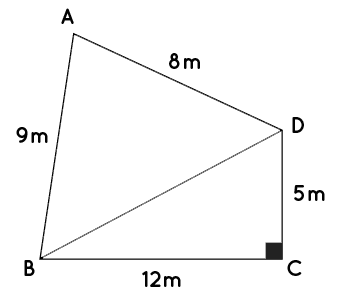
Now, apply Pythagoras theorem in ΔBCD
BD2 = BC2 +CD2
⇒ BD2 = 122+52
⇒ BD2 = 169
⇒ BD = 13 m
Now, the area of ΔBCD = (½ × 12 × 5) = 30 m2
The semi perimeter of ΔABD
(s) = (perimeter/2)
= (8 + 9 + 13)/2 m
= 30/2 m
= 15 m
Using Heron’s formula,
Area of ΔABD = √s(s – a)(s – b)(s – c)
= √15(15 – 9)(15 – 8)(15 – 13)
= √15 × 6 × 7 × 2
= 6√35
= 35.5 m2 (approx.)
Area of ΔABD = 35.5 m2
∴ The area of quadrilateral ABCD = Area of ΔBCD+Area of ΔABD
= 30 m2+35.5m2 = 65.5 m2
2. Find the area of a quadrilateral ABCD in which AB = 3 cm, BC = 4 cm, CD = 4 cm, DA = 5 cm and AC = 5 cm.
Answer – First, construct a diagram with the given parameter.
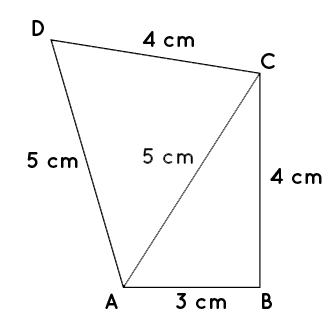
For ∆ABC, consider
AC2 = AB2 + BC2
AC2 = 32 + 42 = 25
AC = 5
Thus, it can be concluded that ΔABC is a right angled at B.
So, area of ΔABC = (½ × 3 × 4) = 6 cm2
Now, In ∆ADC
The semi perimeter of ΔADC (s) = (perimeter/2) = (5 + 5 + 4)/2 cm = 14/2 cm = 7 m
Now, using Heron’s formula,
Area of ΔADC = √[s(s – a)(s – b)(s – c)]
= √[7(7 – 5)(7 – 4)(7 – 5)]
= √[7 × 2 × 3 × 2]
= 2√21 cm2
Area of ΔADC = 9.2 cm2 (approx.)
Area of the quadrilateral ABCD = Area of ΔADC + Area of ΔABC
= 9.2 cm2 + 6 cm2
= 15.2 cm2
3. Radha made a picture of an aeroplane with coloured paper as shown in Fig 12.15. Find the total area of the paper used.
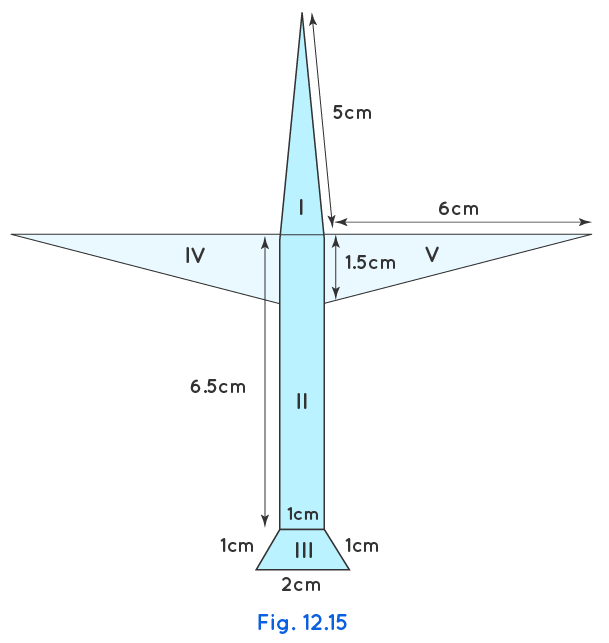
Answer – For For the triangle marked as I
It is an isosceles triangle, therefore a = 5 cm, b = 5 cm, c = 1 cm
Semi Perimeter: (s) = (Perimeter/2)
s = (a + b + c)/2
= (5 + 5 + 1)/2
= 11/2
= 5.5 cm
By using Heron’s formula,
Area of triangle marked I = √s(s – a)(s – b)(s – c)
= √5.5 (5.5 – 5) (5.5 – 5) (5.5 – 1)
= √5.5 × 0.5 × 0.5 × 4.5
= √6.1875 cm
= 2.5 cm2 (approx.)
For the rectangle marked as II:
The measures of the sides are 6.5 cm, 1 cm, 6.5 cm, and 1 cm.
Area of rectangle = length × breadth
= 6.5 cm × 1 cm
= 6.5 cm2
For the trapezium marked as III
It is a trapezium whose parallel sides are 1 cm and 2 cm as shown in the adjoining figure. Its height is given by
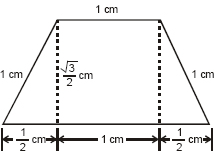
h =
=
=
Note: The perpendicular distance between the parallel sides is called the height of the trapezium.
Area of trapezium = 1/2 × sum of parallel sides × distance between them
= 1/2 × (2 + 1) ×
= 1/2 × 3 × 0.9
= 1.4 cm2 (approx.)
For the triangle marked as IV and V
Triangles IV and V are congruent right-angled triangles with base 6 cm and height 1.5 cm.
Area of the triangle = 1/2 × base × height
= 1/2 × 6 × 1.5
= 4.5 cm2
Area of two triangles (IV and V) = 4.5 cm2 + 4.5 cm2 = 9 cm2
Total area of the paper used = Area I + Area II + Area III + Area IV + Area V
= 2.5 cm2 + 6.5 cm2 + 1.4 cm2 + 9 cm2 = 19.4 cm2
Thus, the total area of the paper used is 19.4 cm2 (approx.).
4. A triangle and a parallelogram have the same base and the same area. If the sides of the triangle are 26 cm, 28 cm and 30 cm, and the parallelogram stands on the base 28 cm, find the height of the parallelogram.
Answer – It is given that the parallelogram and triangle have equal areas.
The sides of the triangle are given as 26 cm, 28 cm and 30 cm.
So, the perimeter = 26 + 28 + 30 = 84 cm
its semi perimeter = 84/2 cm = 42 cm
Now, by using Heron’s formula, area of the triangle = = √s(s – a)(s – b)(s – c)
= √[42(42 – 26)(42 – 28)(42 – 30)] cm2
= √[42 × 16 × 14 × 12] cm2
= 336 cm2
Now, let the height of parallelogram be h.
As the area of parallelogram = area of the triangle,
28 cm× h = 336 cm2
∴ h = 336/28 cm
So, the height of the parallelogram is 12 cm.
5. A rhombus shaped field has green grass for 18 cows to graze. If each side of the rhombus is 30 m and its longer diagonal is 48 m, how much area of grass field will each cow be getting?
Answer – Draw a rhombus-shaped field first with the vertices as ABCD. The diagonal AC divides the rhombus into two congruent triangles which are having equal areas. The diagram is as follows.
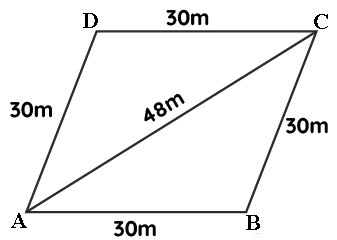
Consider the triangle BCD,
Its semi-perimeter = (48 + 30 + 30)/2 m = 54 m
Using Heron’s formula,
Area of the ΔBCD
=
= m2
= m2
= 432 m2
∴ Area of field = 2 × area of the ΔBCD = (2 × 432) m2 = 864 m2
Thus, the area of the grass field that each cow will be getting = (864/18) m2 = 48 m2
6. An umbrella is made by stitching 10 triangular pieces of cloth of two different colours (see Fig.12.16), each piece measuring 20 cm, 50 cm and 50 cm. How much cloth of each colour is required for the umbrella?
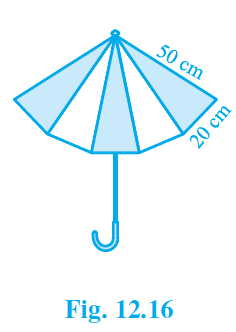
Answer – For each triangular piece, The semi perimeter will be
s = (50+50+20)/2 cm = 120/2 cm = 60cm
Using Heron’s formula,
Area of the triangular piece
=
= √[60(60 – 50)(60 – 50)(60 – 20)] cm2
= √[60 × 10 × 10 × 40] cm2
= 200√6 cm2
∴ The area of all the triangular pieces = 5 × 200√6 cm2 = 1000√6 cm2
7. A kite in the shape of a square with a diagonal 32 cm and an isosceles triangle of base 8 cm and sides 6 cm each is to be made of three different shades as shown in Fig. 12.17. How much paper of each shade has been used in it?
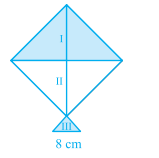
Answer – As the kite is in the shape of a square, its area will be
A = (½) × (diagonal)2
Area of the kite = (½) × 32 × 32 = 512 cm2.
The area of shade I = Area of shade II
512/2 cm2 = 256 cm2
So, the total area of the paper that is required in each shade = 256 cm2
For the triangle section (III),
The sides are given as 6 cm, 6 cm and 8 cm
Now, the semi perimeter of this isosceles triangle = (6 + 6 + 8)/2 cm = 10 cm
By using Heron’s formula, the area of the III triangular piece will be
=
= √[10(10 – 6)(10 – 6)(10 – 8)] cm2
= √(10 × 4 × 4 × 2) cm2
= 8√5 cm2
= 17.92 cm2 (approx.)
8. A floral design on a floor is made up of 16 tiles which are triangular, the sides of the triangle being 9 cm, 28 cm and 35 cm (see Fig. 12.18). Find the cost of polishing the tiles at the rate of 50p per cm2.
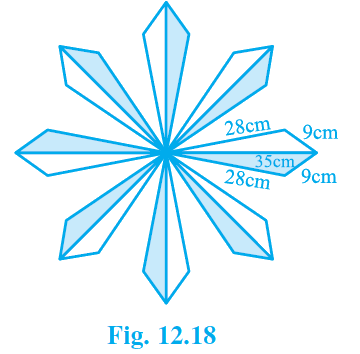
Answer – The semi perimeter of the each triangular shape = (28+9+35)/2 cm = 36 cm
By using Heron’s formula,
The area of each triangular shape will be
=
=
=
= 36√6 cm2 = 88.2 cm2
Now, the total area of 16 tiles = 16 × 88.2 cm2 = 1411.2 cm2
It is given that the polishing cost of tiles = 50 paise/cm2
∴ The total polishing cost of the tiles = Rs. (1411.2×0.5) = Rs. 705.6
9. A field is in the shape of a trapezium whose parallel sides are 25 m and 10 m. The non-parallel sides are 14 m and 13 m. Find the area of the field.
Answer – Given ABCD is a field. Draw CG ⊥ AB from C on AB, and CF parallel to DA.
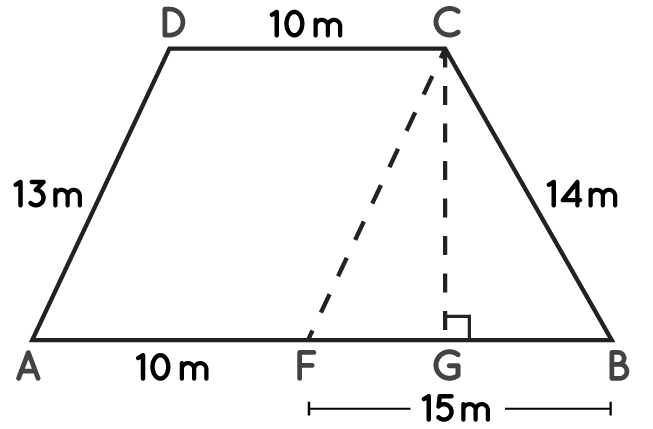
DC = AF = 10 m, DA = CF = 13 m (opposite sides of parallelogram)
So, FB = 25 – 10 = 15 m
In ∆CFB, a = 15 m, b = 14 m, c = 13 m.
Semi Perimeter(s) = (a + b + c)/2
s = (15 + 14 + 13)/2
s = 42/2
s = 21 m
By using Heron’s formula,
Area of ∆CFB = √s(s – a)(s – b)(s – c)
= √21(21 – 15)(21 – 14)(21 – 13)
= √21 × 6 × 7 × 8
= 84 m2
Area of ∆CFB = 1/2 × base × height
84 = 1/2 × BF × CG
84 = 1/2 × 15 × CG
CG = (84 × 2)/15
CG = 11.2 m
Area of trapezium ABCD = 1/2 × sum of parallel sides × distance between them
= 1/2 × (AB + DC) × CG
= 1/2 × (25 + 10) × 11.2
= 196 m2
Hence the area of the field is 196 m2.

Leave a Reply